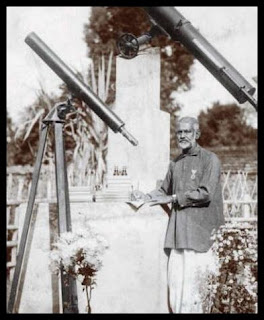Top 5 Astronomers in Modern India | You must know
He, the Father of modern Indian astronomy, was born in Chennai on 10 august 1927. After completing his master's from madras university, he went to Harvard Graduate School of Astronomy in America for Ph.D, where he discovered a comet called 'Bappu-Bok-Newkirk' with two of his colleagues. He later then discoverers an effect called Wilson-Bappu Effect with American astronomer Olin Chaddock Wilson. The discovery opened a field in the research of the stellar chromosphere. When he returned to India, his effort made it possible to build an optical observatory at Kavalur, Tamil Nadu, which later named after him - Vainu Bappu observatory. He was also the head of the team who construct the observatory in Nainital. He died on 19 august 1982.
Awards - Honorary Member of American Astronomical Society, Honorary Foreign Fellow of Belgium Academy of Sciences, etc...
2. Anil Kumar Das :
Awards - Honorary Member of American Astronomical Society, Honorary Foreign Fellow of Belgium Academy of Sciences, etc...
2. Anil Kumar Das :
 |
| Image source - Indian National Science Academy Public domain, via Wikimedia commons |
He was born on 1 February 1902 in the Kusthia District in Bengal (now in Bangladesh). He completed his bachelor's and master's in physics from Priendecy college. And for Ph.D., he went to Paris and worked with the brilliant scholars at that time. When he returned to India, he works as an Assistant Meteorologist in Indian Meteorological Service in March 1930. Most of his contributions are in the field of solar physics as an experimenter in the spectrophotometric. He also studied sunspots and the chromosphere. He contributed significantly to the development of the Kodaikanal Observatory. A newly discovered crater on the far side of the moon was named after him - Crater Das by the International Astronomical Union in its 14th General Assembly at Brighton, England. He died on 18 February 1961.
Awards -Padmashri, a Fellow of the Royal Astronomical Society, a Fellow of the National Institute of Sciences (now the Indian National Science Academy), etc...
3. Radha Gobinda Chandra :
Awards -Padmashri, a Fellow of the Royal Astronomical Society, a Fellow of the National Institute of Sciences (now the Indian National Science Academy), etc...
3. Radha Gobinda Chandra :
 |
| Image source - Jessore.Info , Public domain, via Wikimedia Commans |
He was born in July 1878 in Bengal (present time Bangladesh). He did not have any type of degree, even he failed for the secondary school certificate many times. From his childhood, he had the great interest in stars in the sky, and so he started looking sky daily. He discovered Nova Aquila-3 and then reported to Harvard Observatory in 1918. The first international member of the AAVSO was Italian Giovanni B. Lacchini of Faenza. In his lifetime, he contributed more than 58,000 observations to the AAVSO. And then Radha Govinda Chandra of, who made over 49,700 observations. In 1954, Chandra retired from observing at the age of 76. He was asked to move to the AAVSO telescope in India. He died on 3 April 1975.
Awards - French Officer d’ Academic Brevet and Badges, etc...
4. Pathani Samanta :
Awards - French Officer d’ Academic Brevet and Badges, etc...
4. Pathani Samanta :
 |
| Image by Prateek Pattanaik, CC BY-SA 4.0 , via Wikimedia Commons |
He was a naked eye astronomer, born on 13 December 1835 in Nayagrah district, Odisha. He did not have any formal education What he learned was traditional knowledge in Sanskrit. He was not aware of the works of Newton, Galileo, Kepler, Aryabhata, and also, he had not any idea of Udaipur observatories. He was also not aware of the heliocentric model solar system, but he predicated the sun is at the center of the solar system, and all planet revolves around it (the Planets which we can saw with naked eyes). Even he also said that the moon orbits the Earth. The only problem of his predication that he assumed Earth as stationary at a point. He also measured an accurate distance from the sun to Earth with a bamboo pipe. His research and calculation were written in Siddhanta Darpana. He died in 1904 at 67 age.
Awards -Harichandan Mahapatra, Mahamahopadhyay, etc...
5. Gopal Krishna :
He is a radio astronomer born on 12 March 1948 in the capital of India(Delhi). He completes his graduation from Agra University and later moved to Mumbai University for a Ph.D. He has developed a relativistic-beam model which can use in ascertaining the luminosity of galaxies. It is also used is quasars as well as in studying the cosmological evolution of linear sizes. He is also credit for the discovery of galaxies and clusters at high redshifts.
Awards - Shanti Swarup Bhatnagar Prize, etc...
Awards -Harichandan Mahapatra, Mahamahopadhyay, etc...
5. Gopal Krishna :
He is a radio astronomer born on 12 March 1948 in the capital of India(Delhi). He completes his graduation from Agra University and later moved to Mumbai University for a Ph.D. He has developed a relativistic-beam model which can use in ascertaining the luminosity of galaxies. It is also used is quasars as well as in studying the cosmological evolution of linear sizes. He is also credit for the discovery of galaxies and clusters at high redshifts.
Awards - Shanti Swarup Bhatnagar Prize, etc...



